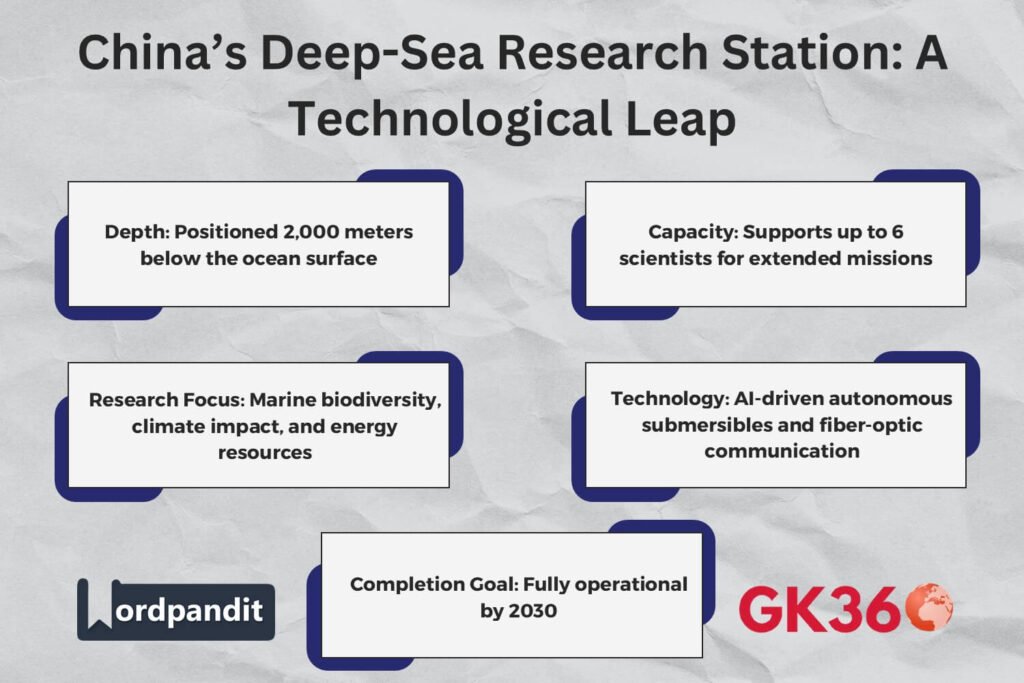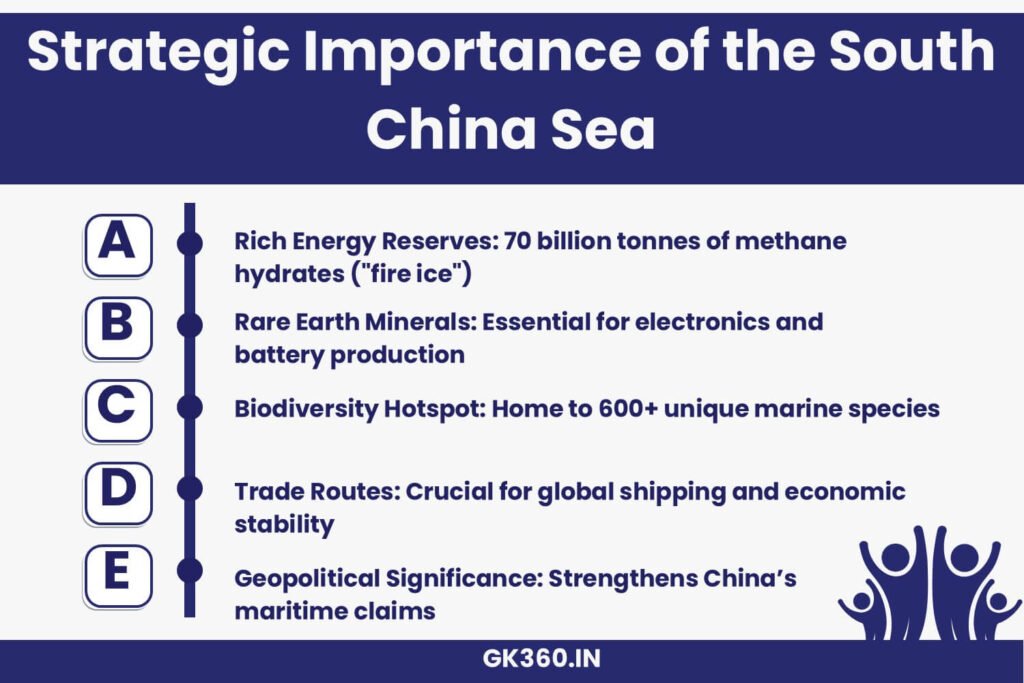China’s Deep-Sea Research Station: A Game-Changer in South China Sea Exploration
Introduction
China has taken a monumental step in marine science and geopolitical strategy by approving the construction of an advanced deep-sea research station in the South China Sea. Often referred to as a “deep-sea space station,” this facility will be among the world’s deepest underwater installations, positioned 2,000 meters (6,560 feet) beneath the ocean surface.
Set to be fully operational by 2030, this high-tech research station is expected to revolutionize marine exploration and reinforce China’s strategic dominance in the resource-rich South China Sea. Housing up to six scientists for extended missions, the facility will provide real-time research capabilities in extreme deep-sea conditions.

Table of Contents
- Project Overview: China’s Deep-Sea Research Station
- Research Objectives: Unlocking the Ocean’s Secrets
- Technological Marvel: Innovations Driving the Project
- Geopolitical & Economic Impact of the South China Sea
- Human vs AI: The Role of Scientists in Deep-Sea Exploration
- Power Source & Historical Comparisons
- Challenges & Future Implications
- FAQs
- Conclusion & Call-to-Action
Project Overview: China’s Deep-Sea Research Station
China’s approval of this deep-sea research station marks a significant milestone in marine exploration. The facility will serve as a permanent underwater hub for scientific research, surveillance, and resource extraction.
🏗 Key Features:
- Depth: 2,000 meters below the surface
- Capacity: Up to 6 scientists for extended missions
- Expected Completion: 2030
- Key Areas of Study: Marine biodiversity, climate impact, tectonic activity, and energy resources
This station will enhance China’s capabilities in deep-sea monitoring, energy exploration, and military surveillance.
Research Objectives: Unlocking the Ocean’s Secrets
The primary goal of this research station is to study cold seep ecosystems, which are areas where methane and other hydrocarbons escape from the ocean floor.
🔬 Key Research Areas:
- Methane Flux Monitoring: Understanding how methane contributes to climate change.
- Deep-Sea Biodiversity Studies: Observing rare marine species and their adaptation to extreme environments.
- Tectonic Activity Surveillance: Monitoring underwater geological movements and earthquake risks.
- Energy Resource Exploration: Investigating methane hydrate extraction for future energy use.
The findings from this research could have global implications in energy, climate science, and medicine.
Technological Marvel: Innovations Driving the Project
This deep-sea space station will integrate cutting-edge marine technology, making it a global leader in underwater exploration.
🔧 Advanced Technologies Used:
- Autonomous Submersibles: Equipped with AI-driven sensors for real-time ocean data collection.
- Deep-Sea Fiber-Optic Network: Enhancing underwater communication for continuous data transmission.
- Life-Support Systems: Designed to sustain human presence for long-duration missions.
- Seabed Surveillance Grid: A network of sensors and cameras monitoring deep-sea activities.
By implementing these technological innovations, China is shifting from a marine technology follower to a global leader.
Geopolitical & Economic Impact of the South China Sea
The South China Sea is not just a research site—it’s a highly contested region rich in energy resources and strategic importance.
🌏 Why This Region Matters:
- 70 Billion Tonnes of Methane Hydrates (“Fire Ice”) – A future energy game-changer.
- Rare Minerals – Deposits of cobalt and nickel essential for electronics and batteries.
- Marine Biodiversity Hotspot – Over 600 unique species with medical research potential.
- Strategic Trade Routes – Crucial for global shipping and supply chains.
By establishing this underwater research base, China strengthens its territorial claims, much like Russia’s deep-sea Arctic exploration.
Human vs AI: The Role of Scientists in Deep-Sea Exploration
While AI-driven underwater vehicles have improved deep-sea research, human presence remains irreplaceable.
🤖 Why Scientists Are Still Essential:
- AI Limitations: Robotic submersibles cannot fully interpret complex ecological interactions.
- Real-Time Adaptation: Humans can adjust research methodologies instantly.
- Hands-On Experiments: Some tests require direct handling, which robots cannot replicate.
China’s project reinforces the crucial role of human expertise in underwater research.
Power Source & Historical Comparisons
China has not disclosed the power source for this facility, but experts speculate it could be nuclear-powered, similar to past deep-sea missions.
🔍 Historical Precedents:
- 🇺🇸 U.S. Submarine NR-1 – A nuclear-powered research vessel used for seabed mapping.
- 🇷🇺 Russia’s AS-12 Losharik – A deep-sea submersible used for classified operations.
If China adopts nuclear technology, this station could sustain long-term missions without external refueling.
Challenges & Future Implications
Despite its advancements, China’s deep-sea project faces significant challenges:
⚠ Key Challenges:
- Extreme Pressure & Conditions: Maintaining life-support at 2,000m depth is difficult.
- Environmental Concerns: Extracting deep-sea resources may disrupt fragile ecosystems.
- Geopolitical Tensions: The station may escalate territorial disputes with neighboring countries.
Despite these challenges, the project marks a new era of marine dominance.
FAQs
1️⃣ Why is China building a deep-sea research station?
China aims to advance marine science, explore energy resources, and reinforce geopolitical influence in the South China Sea.
2️⃣ What are the potential benefits of this research station?
It could lead to breakthroughs in climate research, energy extraction, and deep-sea biodiversity studies.
3️⃣ How does this project compare to other deep-sea stations?
China’s station will be one of the deepest and most technologically advanced underwater facilities.
4️⃣ Will this station impact South China Sea territorial disputes?
Yes, it could strengthen China’s maritime claims, increasing tensions with neighboring nations.
5️⃣ Could AI replace human scientists in deep-sea research?
Not entirely—human expertise remains vital for real-time analysis and decision-making.
Conclusion
China’s deep-sea research station in the South China Sea marks a transformative leap in marine science, technological innovation, and geopolitical strategy. Positioned at a depth of 2,000 meters, this facility will enable real-time deep-sea research, unlocking new insights into climate change, biodiversity, and undersea energy resources.
Beyond its scientific value, this station underscores China’s ambition to establish dominance in the resource-rich and geopolitically contested South China Sea. With trillions of dollars in trade passing through the region annually and vast methane hydrate and mineral reserves, this project could reshape maritime power dynamics for decades to come.
However, the initiative is not without challenges. Questions remain about the environmental impact of deep-sea resource extraction, the sustainability of long-term human presence underwater, and how this station will affect geopolitical tensions with other nations that lay claim to the South China Sea.
Key Takeaways
| Aspect | Details |
|---|---|
| Project Scope | China’s deep-sea research station will be positioned 2,000 meters below the ocean and operational by 2030. |
| Research Focus | Includes marine biodiversity, methane flux monitoring, tectonic activity, and energy exploration. |
| Technological Advancements | Uses AI-driven submersibles, fiber-optic networks, seabed sensors, and advanced life-support systems. |
| Economic Impact | Rich in methane hydrates and rare minerals, supporting future energy needs and industrial demand. |
| Geopolitical Influence | Enhances China’s dominance in the South China Sea, reinforcing territorial claims. |
| Challenges | Extreme underwater pressure, environmental risks, and potential geopolitical tensions. |
| Human Role in Exploration | Despite AI advancements, human scientists remain critical for real-time adaptation and analysis. |
Related Terms:
- China Deep-Sea Research Station
- South China Sea Exploration
- Marine Biodiversity Research
- Deep-Sea AI Technology
- Methane Hydrate Extraction
- Ocean Climate Impact Studies
- Geopolitical Strategy in South China Sea
- Advanced Underwater Research
- Deep-Sea Surveillance and Monitoring
- Future of Marine Science






